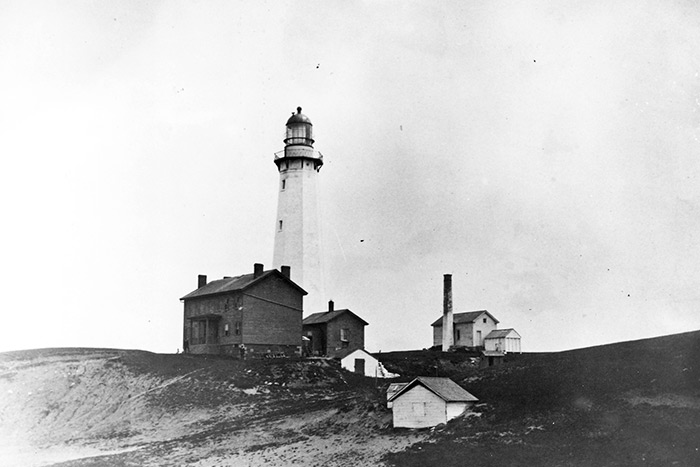Building the Montauk Lighthouse: George Washington, the English & a Southold Resident

In March of 1792, George Washington was in his third year as President of the United States. At 60, his health was failing. He was getting hard of hearing. He began to move more stiffly. And people noticed it. Also, the members of his young administration—Jefferson, Hamilton and Madison—were at one other’s throats about what the future country should look like. And just a month earlier, Hamilton’s entire new banking system had almost collapsed. Hamilton, with Washington’s quiet encouragement, wanted a strong national government with financial underpinnings. Madison and Jefferson wanted a loose assemblage of states remaining largely agricultural.
In that third year of his presidential term, Washington would have to decide if he wanted to run for a second term. In fact, he wanted nothing but to retire to his Virginia plantation in peace. But his young cabinet members said that so many important decisions needed to be made, they feared the country would fall apart if Washington weren’t there. Indeed, both Hamilton and Jefferson said if Washington retired, they would too.
It was in this setting that a man named, a much-respected East Ender from Southold, brought to Washington’s attention the need for a Lighthouse at Montauk. L’Hommedieu grew up in a wealthy Dutch, English and French Huguenot household, received a degree from Yale and became a lawyer. In 1792, he was a state senator and former member of the Continental Congress. In that capacity, he had come to know Washington well.
Before the British were defeated, but after the British had won the Battle of Long Island in 1776, much of the British fleet lay at anchor in Gardiner’s Bay. For navigation purposes, in bad weather and fog, the British Navy would build bonfires on the hill at what is today Turtle Hill at Montauk Point so British ships could navigate by the light. In 1792, there was no income tax, little help with cash from the individual states, and the largest revenue source for the federal government came only from the taxes collected on imports coming into the United States from foreign lands. It wasn’t much. But it needed to be encouraged. As New York City accounted for a third of all imports that came into the country, it made perfect sense to build a lighthouse out there at the tip of Long Island to guide the ships in safely.
George Washington had never been to Montauk, though in 1790, in the first year of his presidency, he had taken a four-day outing by horse-drawn coach into the woods of eastern Long Island. Washington’s “White House” was then a house provided for him in lower Manhattan by New York’s Governor Clinton. As a younger man, Washington had always been in the most robust health, riding dozens of miles a day to attend to the farming of his estate at Mount Vernon, and, later, doing the same thing during the seven years of the Revolutionary War. During those years, the tall, regal figure of General Washington, always fearlessly at the point of battle, sat atop his white horse and led his rag-tag army into and out of dozens of battles, most of which he lost, but after which he rose again to fight another day.
After the war, as America’s hero, he appeared before huge crowds in many American cities and towns on horseback in celebration of the founding of the country. But in 1789, when he became president, he found himself spending every day at his desk, dealing with volumes of mail, documents and meetings. Those around him said he didn’t look well. So in April 1790, as spring came, he went off to Long Island on a four-day outing, not on horseback but in a horse-drawn coach, with servants bringing up his riding horses behind. He made no plan. He rode out two days and came back in the last two. But he kept a diary. In New Utrecht, he “dined at the house of a Mr. Barre. The man was obliging but little else recommended.” He had his horses watered in Hempstead. In West Bay Shore he stayed at the Sagtikos Manor, home of Squire Isaac Thompson. The next day he “halted awhile” at Samuel Green’s place in West Sayville before heading out to spend the night at Hart’s Tavern in Patchogue. The next day he went north and spent the night in Setauket at a tavern owned by Austin Roe, a former member of Washington’s Culper Spy Ring, which he declared a “tolerably decent tavern.” Then he went back to New York City.
His health seemed to be restored with this trip, but a month later he caught pneumonia, took to his bed, and a week later was told death was imminent. One wonders what this country would be like today, given the factions tearing it apart back then, had he died. But he didn’t die. He rallied and made a miraculous recovery.
In any case, he got well enough to take charge again and ordered L’Hommedieu, in 1792, to oversee the construction of a lighthouse at Montauk. It would be the first lighthouse constructed in the State of New York and the fourth in the young nation.
L’Hommedieu bought Turtle Hill for $255.12 and then, getting help, drew up plans for the lighthouse and let it out to bid. The foundations would be 13 feet into the earth and 9 feet thick. The sandstone lighthouse tower would rise 110.5 feet, have a circumference at the base of 28 feet with walls 6 feet thick at the base and 3 feet thick at the top. They would be made from huge heavy blocks hauled to New London, Connecticut by horse-drawn wagons and then from New London to Sag Harbor by boat and then by wagons again. There would be a two-story residential facility for a lighthouse keeper and his family in an adjacent building.
A builder named John McComb Jr. won the job with a bid of $22,300. He had previous experience building a lighthouse on a promontory in Cape Henry, Virginia. McComb broke ground in the spring of 1796. The job was completed in the fall, with the light provided by a wick soaked in whale oil carried up to the top from nine whale oil storage cisterns sunk in the ground at the base. Whale oil was used until 1850, then lard oil until 1860, then kerosene and, finally, electricity. Today, a new lens, a strong DCH-224 airport beacon, has replaced the 150-year-old French-manufactured Fresnel lens, which, down on the ground floor, is on display for the general public.
The light went into service in March 1797. The nation’s capital had moved to Philadelphia (pending an ultimate move to D.C.) and Washington, now frail, was in the last month of his two-term presidency. He must have been happy to learn Montauk had gone into service. He would die two years later at the age of 67, in retirement—sadly, a short retirement. His wife, family and friends would be at his bedside in Mount Vernon, Virginia. He will have given his life for his country.
During its 220 years, the light has guided mariners safely in and out of New York waters. Until the construction of the Statue of Liberty in 1888, the Montauk Light would be the first bit of America that immigrants would see on their way to their new land.
Numerous shipwrecks have happened anyway, mostly in storms, and some of them right on the rocks in front of the lighthouse. In 1856, a lighthouse keeper named Patrick T. Gould climbed down the boulders in the midst of a gale force snowstorm to rescue the mariners aboard the brig Flying Cloud from drowning. He received a gold medal from the Lifesaving Benevolent Association of New York for his efforts.
In the early 1960s, the United States Coast Guard, which was now in charge of lighthouses along the country’s shores, ordered that the Montauk Lighthouse be abandoned and torn down in a cost-savings program. Saving historic sites was not considered important then. For example, the beautiful Penn Station in New York City was torn down in that era. In late August of 1966, this newspaper led the first of a series of demonstrations that eventually caused the Coast Guard to withdraw the order to abandon Montauk Lighthouse. In October that year, the U.S. Congress passed a law creating a National Register of Historic Places, and in 1969 Montauk Lighthouse was placed upon it. On March 2, 2012, the lighthouse was designated a National Historic Landmark.
Today, the light itself is managed by the Coast Guard from a headquarters on Star Island, but the building and grounds are now a historic museum run by the Montauk Historical Society. Feel free to visit, climb up the 137 iron steps to the top, and look out to sea in almost every direction. It’s a wonderful experience.
* * *
Up top of the lighthouse tower, pretend it is January 22, 1781. The war of independence is stalemated. But British Men-o-War are still in Gardiner’s Bay, and you can see them there. That day, three of those ships, the Culloden, the Bedford and the America head out to battle. The word has come in that three Men-O-War ships of the French fleet, supporting the rebels, have come out to Long Island Sound from Connecticut near by. The British will engage them. The Culloden and the others are 74-gun ships that easily outgun the French, and it is believed the English will prevail.
A huge storm comes up. The French ships sail quickly and safely back to port. But the English are on the hunt. By late that afternoon, with the winds howling, the Bedford is dismasted, the America loses its way and is not found for seven days, and the Culloden is driven onto some rocks coming back to Gardiner’s Bay. Her hull is torn open, but even so, the captain somehow manages to get her off the rocks and up onto a nearby beach, where she is further assaulted by the sea as the storm moves off. The 400 sailors onboard wade safely through the surf to shore. But the Culloden is a wreck. The sailors salvage cannon and masts the next day and arrange for their transport to British held New York City, but that’s about it.
Today, at low tide, the skeleton of the Culloden is visible. It is the only underwater Historic Site in the State of New York and is often visited by skin-divers who know never to remove any of the artifacts they find there.
The stretch of beach where it resides is called, of course, Culloden Point.
“I stand as on some mighty eagle’s beak, / Eastward the sea absorbing, viewing (nothing but sea and sky), / The tossing waves, the foam, the ships in the distance, / The wild unrest, the snowy curling caps-that inbound urge / and urge of waves, / the shores forever.”—Walt Whitman, Leaves of Grass, 1888



